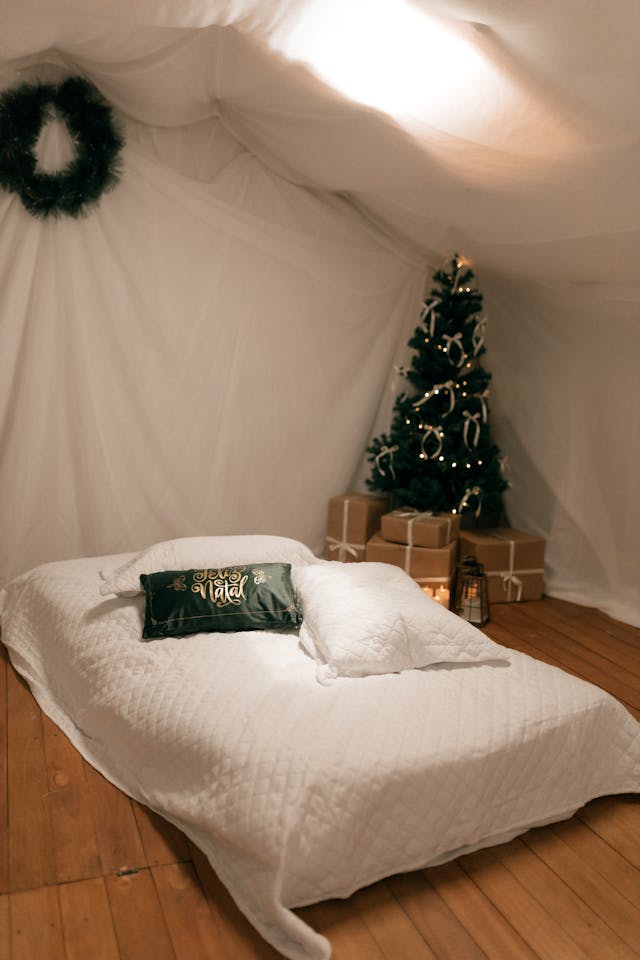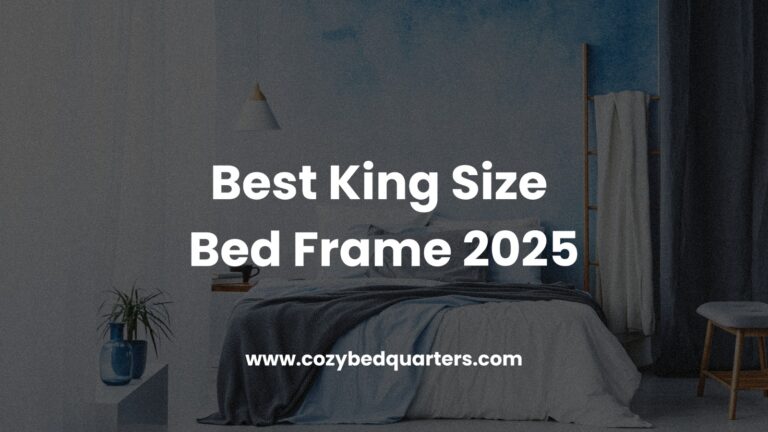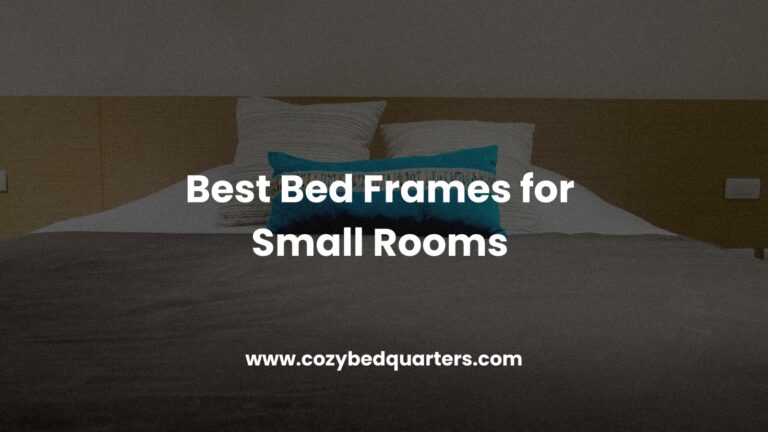Comparing Bed Frame Materials: Wood vs Metal Guide
Comparing bed frame materials like wood and metal helps you find the perfect match for your space. This guide breaks down durability, style, cost, and support so you can choose confidently.
In this guide on comparing bed frame materials, we’ll look at how wood and metal stack up across multiple factors—so you can choose the one that truly fits your needs, tastes, and budget.
Key Takeaways: Comparing Bed Frame Materials
- Comparing bed frame materials highlights tradeoffs: wood excels in warmth and stability; metal wins on price, weight, and easy moving.
- Wood bed frames provide warmth, solidity, and aesthetic versatility; metal bed frames tend to be more affordable, lightweight, and modern.
- Prioritize weight capacity, noise control, maintenance, cost, and your bedroom’s aesthetic.
- Quality construction matters more than material alone.
- Match your frame to your mattress dimensions for the best fit.
Matching Your Bed Frame to Your Mattress Size
To get the right bed frame, always start with your mattress dimensions.
Measure the length, width, and even depth of your mattress. Some mattresses—like twin XL or California King—are nonstandard, so double-check those dimensions. Remember, the frame, headboard, or footboard may add a few inches. Also consider clearance for bedding, side tables, and walking space.
If you’d like a trustworthy reference, see the Sleep Foundation’s Mattress Size Guide, which outlines standard and specialty mattress dimensions in one place.
Considerations for Matching Frame + Mattress
- Measure precisely: Confirm mattress width, length, and any unusual dimensions.
- Account for frame overhang: Headboards, footboards, and side rails may add width or height.
- Check bedroom clearance: Leave at least 24–30″ on the sides for easy access, and make sure doors/windows aren’t obstructed.
By making sure your frame and mattress align dimensionally, you prevent wobble, uneven support, or gaps.
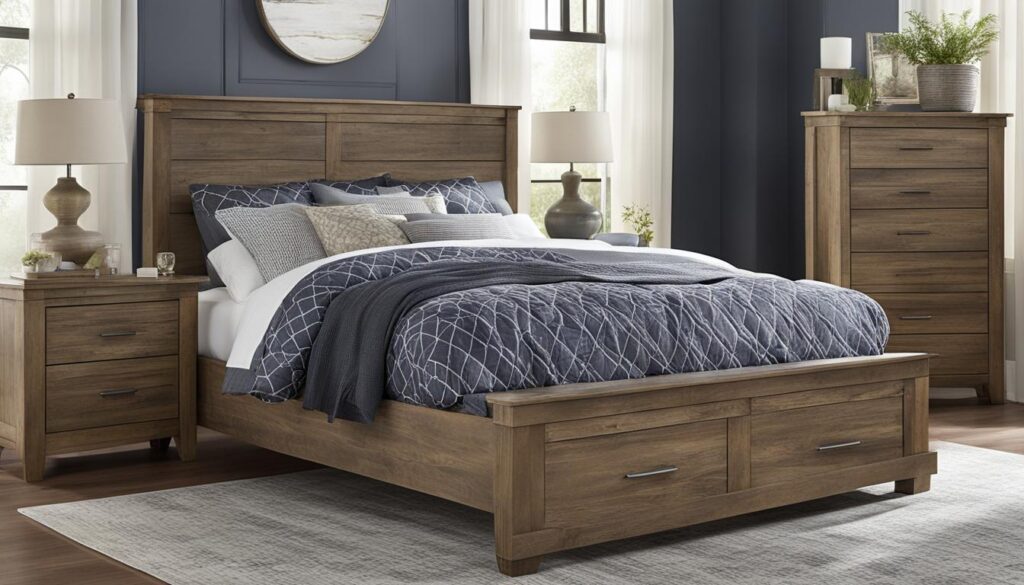
Types of Bed Frame Supports When Comparing Bed Frame Materials
The support system—platform base vs box spring—has a big effect on comfort, mattress life, and height.
There are two primary support systems used in bed frames:
- Platform beds: Slats (closely spaced) or solid panels that support the mattress directly.
- Box springs or foundations: A traditional base that lifts and supports the mattress beneath a fabric covering.
For a deeper comparison, see Architectural Digest’s platform vs. box spring overview.
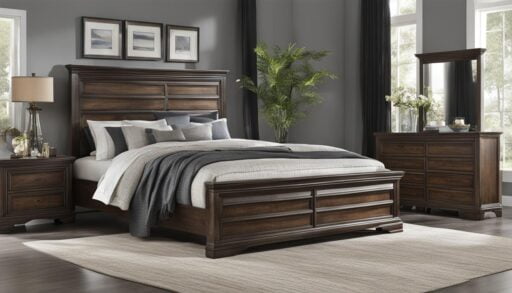
Comparing Wood and Metal Bed Frame Materials
Wood offers warmth, heft, and timelessness; metal offers affordability, lightness, and a sleek silhouette.
Here’s how they compare across key dimensions:
Durability & Strength
Solid hardwood frames (oak, maple, walnut) can last for decades if well cared for. They resist sagging and absorb shock well. However, cheaper woods (particleboard, MDF) may degrade faster.
Metal frames (steel, iron) are strong when well welded or braced. Thin-gauge metal can bend, and joints may loosen over time if hardware isn’t robust.
Noise & Stability
Wood tends to be quieter under load. Proper joinery and tight fittings reduce creaks. Metal frames can creak if bolts loosen; look for locking hardware or cross-bracing to minimize noise.
Weight & Mobility
Wood frames are heavier and harder to move once assembled. Metal frames are lighter and often modular, which makes them easier to shift or disassemble.
Cost
Entry-level wood frames usually cost more than budget metal frames due to material and labor. Premium wood (solid hardwood) can outprice mid-tier metal, while metal offers strong value at lower price points.
Style & Aesthetics
Wood frames suit classic, rustic, boho, or Scandinavian interiors. Metal frames fit minimal, industrial, or modern styles.
Maintenance & Care
Wood benefits from occasional polishing or sealing and protection from moisture. Metal may need touch-up paint or rust protection in humid environments.
Weight Support & Mattress Compatibility
For heavier sleepers or couples, engineering matters more than material. Well-designed wood or metal frames can exceed 1,000 lb capacity with strong center support and closely spaced slats.
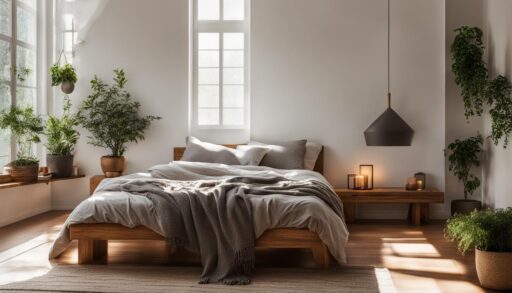
Eco & Sustainability Considerations When Comparing Bed Frame Materials
For an eco-conscious buyer, frame material choice affects carbon footprint, recyclability, and sourcing ethics.
- Renewable wood sourcing: Choose FSC-certified or reclaimed wood frames.
- Metal recyclability: Many steel frames are recyclable at end-of-life.
- Production energy & transport: Local sourcing lowers carbon cost for both wood and metal.
- Chemical treatments: Prefer low-VOC finishes or powder coating; avoid harsh adhesives or finishes.
Eco-Friendly vs Conventional Bed Frame Materials
When comparing bed frame materials, it’s important to weigh environmental impact across sourcing, use, and disposal.
Eco-friendly frames prioritize responsible wood (FSC), recycled metals, or reclaimed materials. Reclaimed wood reduces waste and adds unique character. Conventional wood often relies on particleboard or MDF with chemical adhesives that can off-gas. Conventional metal may use coatings that aren’t eco-optimized.
Recyclability matters: metal frames are often fully recyclable; solid wood can be refinished or repaired and even composted if untreated. Many low-grade composites end up in landfills due to adhesives and fillers.
For eco-conscious buyers, comparing bed frame materials with these criteria supports a healthier home and planet.
Buyer’s Guide to Certifications When Comparing Bed Frame Materials
Certifications help verify safety, sustainability, and low emissions.
FSC (Forest Stewardship Council) confirms responsibly managed forests for wood frames. GREENGUARD or GREENGUARD Gold indicate low chemical emissions for finishes and adhesives. If your frame includes upholstered or foam parts, look for CertiPUR-US® to avoid harmful chemicals. These signals make comparing bed frame materials clearer and safer.
Cost Comparison When Comparing Bed Frame Materials: Short vs Long-Term
Cost isn’t just about the sticker price—it’s about value over time.
Metal frames often win on upfront affordability, making them ideal for renters or guest rooms. Lower-cost models may need earlier replacement.
Solid hardwood frames cost more initially but can last decades with care. Over the long term, durability and timeless style can make them more economical than buying multiple budget frames.
Consider lifetime costs: assembly ease, maintenance, repairability, and warranty coverage. A higher upfront investment in a quality wood or reinforced metal frame may save money over time.

Which Bed Frame Material Is Right for You? Comparing Bed Frame Materials by Lifestyle
Match the choice to your lifestyle and priorities.
Renters or frequent movers: Metal frames are lighter, easier to disassemble, and budget-friendly. A sturdy steel frame can be the most practical option.
Long-term homeowners: Solid hardwood frames offer longevity, repairability, and a look that ages gracefully.
Eco-conscious buyers: FSC-certified wood, reclaimed wood, or recyclable steel frames reduce environmental impact.
Design-focused sleepers: Wood offers wide stylistic range (rustic, farmhouse, Scandinavian). Metal suits industrial, minimal, or modern interiors.
Families: Solid wood frames can feel sturdier and less prone to shifting or squeaking.
By comparing bed frame materials across these scenarios, you can balance cost, durability, style, and sustainability—and choose a frame that supports both your home and your long-term comfort.
Trusted Brand Examples for Comparing Bed Frame Materials
Real-world examples help when comparing bed frame materials.
The Sleep Foundation’s best bed frame roundup covers options across wood and metal with notes on durability, price, and assembly.
Parachute Home emphasizes minimalist wood designs crafted from responsibly sourced hardwoods.
Architectural Digest highlights top-rated platform beds—both wood and metal—focusing on design appeal and long-term usability.
FAQ
- Is a metal or wood bed frame quieter?
- Wood frames tend to be quieter, as metal can creak with movement if joints loosen.
- Which bed frame lasts longer—wood or metal?
- Solid hardwood frames can last decades with maintenance; high-quality metal frames also last long when well engineered and protected from corrosion.
- Are metal bed frames less expensive than wood?
- Generally yes—metal offers better affordability at lower tiers, though premium wood frames can outlast cheaper metal and may be the better long-term value.
Final Thoughts: Comparing Bed Frame Materials
Choosing between wood vs metal bed frames comes down to your priorities—whether you value long-term durability, aesthetics, noise control, or eco credentials. Both materials can provide years of solid support when well built. At Cozy Bed Quarters, we recommend focusing on real specs (weight capacity, slat spacing, hardware quality) more than the label when comparing bed frame materials for your home.















